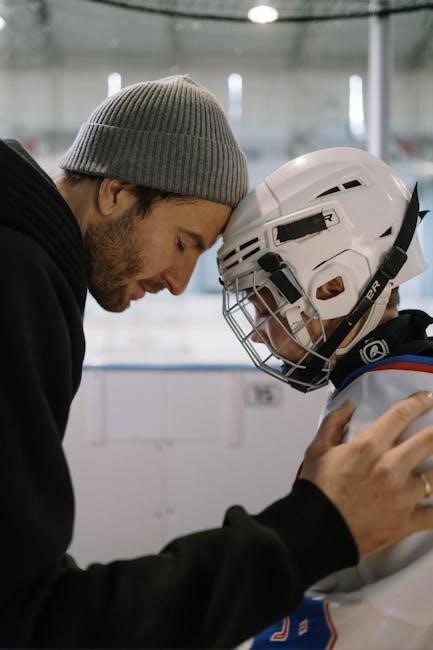Discover the essential techniques for perfect HTV placement with this comprehensive guide. Learn proper positioning, sizing, and alignment tips to ensure professional-looking designs on various garments and accessories.

Tools and Materials Needed for HTV Placement
Essential tools include a ruler, tape measure, heat press, and cutting mat. Additional materials like alignment guides and thermal tape ensure precise and professional HTV application.
Essential Measuring Tools
A ruler or measuring tape is crucial for accurate HTV placement. Use a ruler to measure distances from the neckline or seams. A tape measure ensures proper sizing for different garment types. Alignment grids or laser guides on heat presses help center designs. For precision, a digital caliper can measure small spaces, while a temperature gun ensures the heat press is at the correct temperature. A cutting mat with grid lines aids in aligning vinyl during cutting. These tools collectively ensure proper sizing, positioning, and alignment, making the HTV application process efficient and professional. Always double-check measurements to avoid errors, especially for designs on specific areas like the chest, sleeves, or back.
Heat Press Specifications
A heat press is a vital tool for HTV placement, requiring specific settings for optimal results. Ensure your press has a temperature range of 260°F to 300°F, with adjustable pressure and a timer. For most HTV, set the temperature between 270°F and 300°F, depending on the vinyl type. Pressure should be firm but not excessive to avoid damaging garments. Typical press time ranges from 10 to 20 seconds, with thicker materials requiring longer times. Choose a press size suitable for your projects; a 12×10 inch press is ideal for standard garments. Always pre-heat the press and use a heat-resistant mat. Adjust settings based on fabric type and vinyl thickness for consistent results. Proper calibration ensures vibrant, long-lasting designs. Refer to the manufacturer’s guidelines for specific vinyl recommendations. A reliable heat press is essential for achieving professional-quality HTV applications every time.

Understanding HTV Size Charts
HTV size charts help determine the appropriate design dimensions for various garments, ensuring proper fit and visual appeal across different ages, sizes, and fabric types.
General Size Guidelines for Adults and Kids
For adults, front designs are typically placed 3-3.5 inches below the neckline, centered on the chest. Designs for adults usually range from 8×8 inches for small logos to 12×12 inches for larger graphics. For kids, the size is smaller, with designs measuring 6-8 inches wide, depending on the child’s age and garment size. Toddler designs are even more compact, around 4-6 inches wide. The two-fingers rule is a common guideline: place the top of the design about 1-2 finger widths below the neckline for a balanced look. Garment size charts help ensure the design proportions match the wearer’s size, creating a professional and visually appealing finish. Always measure the garment before applying HTV for precise placement and sizing.
Garment-Specific Sizing Recommendations
For hoodies and sweatshirts, designs can be larger, typically ranging from 10×10 inches to 14×14 inches, depending on the garment’s size. Polo shirts and button-downs often feature smaller logos, usually 3×3 inches to 4×4 inches, placed on the left chest. Sleeve designs should be vertically aligned and sized between 2×2 inches and 4×4 inches for optimal visibility. When placing designs on pants or shorts, keep them smaller, around 5×5 inches, and centered on the leg. Accessories like hats and bags can accommodate designs up to 6×6 inches. Always use a centering tool to ensure alignment and consult the garment’s size chart for precise measurements. Measuring the garment before cutting the HTV ensures a perfect fit and professional finish.

Basic Placement Guidelines for Common Garments
For T-shirts, measure 3-3.5 inches below the neckline for front designs. Hoodies and sweatshirts allow larger designs, while sleeves require vertical alignment. Always center designs for a balanced look.
Front Placement: Center Chest Alignment
Center chest alignment is the most common placement for heat transfer vinyl (HTV) designs. For adult T-shirts, measure 3-3.5 inches below the neckline to position the design. This ensures visibility and balance. For V-neck shirts, align the top of the design 1.5 inches below the neckline. The two-fingers rule is a practical guide: place the design about 1 inch below the neckline, roughly where two fingers fit. Designs should be centered horizontally, ensuring symmetry. Typical design sizes range from 8-10 inches for adults and 6-8 inches for kids. Use alignment tools or a ruler to achieve precise placement. This method works for round-neck, V-neck, and scoop-neck garments, ensuring a professional finish. Proper front placement enhances the overall appearance of the design and garment.
Back Placement: Full-Back Design Positioning
For full-back designs, center the heat transfer vinyl (HTV) between the shoulder seams, ensuring it aligns vertically and horizontally. Measure 2-3 inches below the collar for adult shirts, adjusting based on design size and garment length. The design should fit within the fabric’s usable area, avoiding seams or zippers. Use alignment tools or a ruler to achieve symmetry. Larger designs benefit from a slightly lower placement to accommodate the garment’s natural drape. For consistent results, align the top of the design with the bottom of the collar or use a grid system. Proper positioning ensures the design is visually appealing and professional. Full-back placements are ideal for bold, eye-catching designs, offering maximum visibility and impact.
Sleeve Placement: Logo and Design Alignment
For sleeve placement, align logos or designs 5-6 inches below the shoulder seam for adult shirts, ensuring they are centered and symmetrical. For kids’ sleeves, place designs 3-4 inches below the shoulder seam. Pocket-sized designs, such as small logos or text, should be 2-3 inches above the sleeve cuff for a balanced look. Use alignment tools or measure from the shoulder seam to maintain consistency. For longer sleeves, ensure the design does not wrap too far down, as it may distort during wear. Always consider the garment’s size and the design’s proportions for a professional finish. Proper sleeve placement enhances the overall aesthetic of the design and ensures a polished appearance on any garment.

Advanced Tips for Perfect HTV Alignment
Master precise HTV alignment with advanced techniques like laser-guided tools, grid paper templates, and symmetry checks for professional, balanced designs on any garment type.
Centering Designs Using Alignment Tools
Centering designs is crucial for a polished look; Use alignment tools like laser guides, grid paper, or built-in heat press alignment features to ensure symmetry. Measure the garment’s width and mark the center point with a ruler or tape. For chest designs, align the top of the HTV 2-3 inches below the neckline for adults and 1.5 inches for V-necks. Use a measuring tape to double-check distances. Grid paper can help visualize placement, while laser tools offer precise positioning. Always test alignment on a blank garment first. These methods ensure designs are perfectly centered, enhancing professionalism and appeal. Proper alignment tools simplify the process, making it easier to achieve flawless results every time.
Multi-Design Layouts for Complex Garments
Creating multi-design layouts on complex garments requires careful planning and precision. Start by dividing the garment into zones, such as front, back, sleeves, and hemlines, to distribute designs evenly. Use grid paper or design software to sketch layouts and ensure proper spacing. For sleeves, align smaller designs 2-3 inches apart, while larger ones should be centered. On the back, full-length designs work best, but multi-design layouts can be balanced using symmetry. Always measure the garment to maintain consistent spacing and alignment. Layering smaller designs over larger ones can add depth, but ensure they don’t overlap excessively. Utilize alignment tools like laser guides or rulers to achieve accuracy. Testing layouts on scrap fabric first helps refine placements before applying HTV. This method ensures cohesive, professional results on intricate garments.

Troubleshooting Common Placement Mistakes
Common mistakes in HTV placement often stem from improper measurement or alignment. One frequent error is misaligning the design, especially on curved or irregular surfaces. To avoid this, use alignment tools like laser guides or rulers to ensure accuracy. Another mistake is placing designs too close to seams or edges, which can cause uneven adhesion. Always leave at least 0.5 inches of space from seams. Additionally, oversized or undersized designs can throw off the garment’s balance. Refer to size charts to select appropriate dimensions. For multi-design layouts, ensure spacing is consistent and symmetrical. Finally, test designs on scrap fabric before applying them to the final garment to catch errors early. Addressing these issues ensures professional-quality results and minimizes wasted materials.

Additional Resources for Further Learning
For deeper insights into HTV placement, explore online tutorials and videos that demonstrate step-by-step techniques. Websites like YouTube and crafting blogs offer detailed guides and troubleshooting tips. Additionally, downloadable templates and checklists can help you plan designs more effectively. Join crafting communities or forums to share experiences and learn from others. Many retailers, such as Transfer Express, provide free guides and webinars to enhance your skills. Don’t forget to check out the Ultimate Design Size & Placement Guide for comprehensive resources. These tools will help you master HTV placement and stay updated on the latest trends and best practices in the industry. Continuous learning ensures your designs are always professional and polished.
